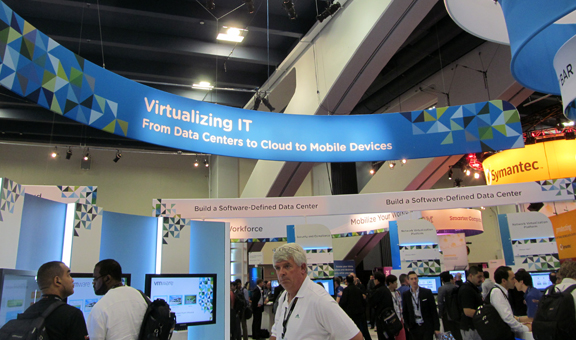VMworld 2013, SF: Separating the Desktop from the Desk
Latest News
August 30, 2013
If you appreciate irony like I do, you’d probably be amused by the thought of attending a virtualization conference in flesh. The latest trend in IT is to move the stack of hardware that used to sit in a climate-controlled server room to the cloud, according to organizers of VMworld 2013 (Moscone Center, San Francisco, Aug 25-19). This led me to wonder whether I ought to log on to the conference from a browser rather than attend in person. Still, Moscone Center is a mere 30 mins away by train from where I live, so I headed out there with my camera and notepad for an old-fashioned exhibit walk. What I discovered is, you need a lot of sophisticated back-end hardware to hide the computer desktop from the user’s physical desk.
My first stop was NVIDIA, the GPU maker showcasing the NVIDIA GRID. The company offers two families of products under the NVIDIA GRID brand. The first, described by the company as Visual Computing Appliance (VCA), is equipped with 8 GPUs, a setup designed to support up to 8 virtual desktops as an appliance, which is easy for small and medium businesses with little to no IT staff to setup and use. Professional design software makers—from Autodesk and SolidWorks to Adobe—are looking at virtual infrastructure, like those powered by NVIDIA GRID, as the future of workstations. Your professional workstations are still there, but they may be a lot harder to see. While some continue to sit on the users’ physical desks (or under them), many will likely become virtual machines, accessible through a browser or lightweight client.
Justin Boitano, NVIDIA GRID’s product marketing director, was demonstrating the second of the two GRID solutions at the show. To showcase the potential of the enterprise-class GRID K1 card, NVIDIA installed a wall equipped by eight display monitors, all running on virtual machines powered by the Dell PowerEdge R720 server (a GRID solution offered by Dell). In this setup, each virtual machine gets its own virtual GPU, a crucial performance-booster for rendering and simulation programs that usually run on physical workstations equipped with GPUs.
Turning the corner, I stumbled on the booth of Teradici, a PC-over-IP solution provider. Teradici launched a few years ago with a remote PC solution, facilitated via a host card (installed inside a workstation) and a client card (installed in a portable desktop box with connector ports). But the company’s technology has gone through various incarnations. The latest addition to its product line is a PC-over-IP solution built right into a AMD GPU. The AMD FirePro R5000 contains a built-in Teradici host card, which allows you to remotely access the GPU’s graphics-boosting power from a client device (for example, a low-powered consumer PC without GPU).
Virtualization also requires middleware that connects the back-end servers to remote users, so solutions from VMware (organizers of the conference) and Citrix will play a bigger role in such setups.
Brett Newman, Microway‘s HPC specialist, observed, “If you were to put the CAD or design software into a virtualized environment without any special software sauce, you would find a much reduced performance. It has to do mostly with the data pass-through on the GPU, which the CAD software relies on a fair bit. Previously you could not easily pass [data] through the GPU at all, or you could but to only one instance. And the [graphics performance] may not be as powerful as what you get on a normal workstation.”
But that’s no longer the case, Newman pointed out, “a little bit due to hardware changing, the driver models changing, and the virtualization software changing.” Microway offers WhisperStation-brand products based on the NVIDIA Tesla, Quadro, GeForce, and GRID GPUs. The virtualization is powered by Citrix software.
If you think workstation vendors—HP and Dell, for example—might shun a pro-virtualization conference, you’d be wrong. They occupy some of the biggest booths at VMworld. Every virtual machine in the private or public cloud is powered by a piece of physical hardware with enough computing resources to support it. Cloud computing isn’t the death knell for desktop workstations. It’s the harbinger to a future where you don’t necessarily need to be at your desk to get access to your computer desktop. Your desktop machine may be miles away, or virtualized in the cloud.
To borrow some words from VMworld’s introductory video to the keynote, “It’s time to expand the impact of virtualization, embrace the public cloud, and deliver mobility securely, time to approach the entire data center as one virtualized automated machine. It’s not a revolution. It’s a radical evolution toward simplicity.”
For more, watch the video report below:
Subscribe to our FREE magazine, FREE email newsletters or both!
Latest News
About the Author
Kenneth Wong is Digital Engineering’s resident blogger and senior editor. Email him at [email protected] or share your thoughts on this article at digitaleng.news/facebook.
Follow DE







